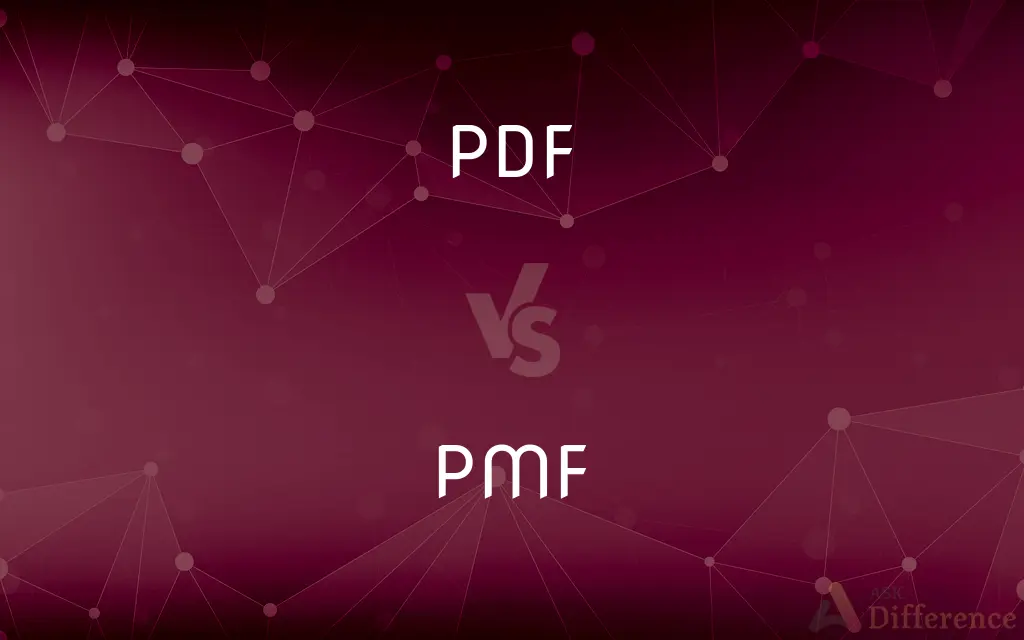PDF vs. PMF — What's the Difference?
By Tayyaba Rehman — Published on December 26, 2023
PDF (Probability Density Function) represents continuous data; PMF (Probability Mass Function) represents discrete data.

Difference Between PDF and PMF
Table of Contents
ADVERTISEMENT
Key Differences
The term PDF stands for Probability Density Function, while PMF stands for Probability Mass Function. PDF deals with continuous random variables, whereas PMF deals with discrete random variables. This means that for any given value in a continuous distribution, the PDF provides the relative likelihood of that value, while the PMF gives the exact probability for a discrete value.
Another distinguishing feature is that the area under the curve of a PDF equals one, signifying the total probability of all outcomes. In contrast, the sum of the probabilities in a PMF equals one.
In practical applications, if you're working with data points that are distinct and countable, you would use a PMF. On the other hand, if you're dealing with data over a continuous range, a PDF would be more appropriate.
Comparison Chart
Type of Variable
Continuous
Discrete
Representation
Probability density at a specific value
Exact probability for specific values
ADVERTISEMENT
Total Probability
Area under the curve equals 1
Sum of all probabilities equals 1
Data Example
Height of people in a city
Number of students in a class
Mathematical Property
Integral over its range is 1
Sum over all possible values is 1
Compare with Definitions
PDF indicates the relative likelihood of a continuous random variable taking a specific value.
The PDF of a person's height can tell us how common or rare that height is in a population.
PMF
PMF assigns probabilities to discrete outcomes.
The PMF for rolling a dice gives each number a probability of 1/6.
PDF gives the density of the probability, not the probability itself.
For any specific height, the PDF might indicate its relative commonness, but not its exact probability.
PMF
PMF gives exact probabilities for specific, countable outcomes.
According to the PMF of a fair coin, the probability of getting heads is 0.5.
PDFs are used in statistical modeling for continuous data.
Using the PDF, one can model the distribution of rainfall amounts in a particular region.
PMF
The sum of all probabilities in a PMF equals 1.
If you sum all the outcomes' probabilities in a PMF, it will always equal 1.
PDF is a function representing continuous probability distributions.
The height of the curve at any point is given by the PDF.
PMF
PMFs are used to describe the distribution of discrete random variables.
If examining how many cars pass by in an hour, a PMF could represent the data.
The integral of a PDF over its entire range is always equal to 1.
When integrating the PDF of a continuous random variable, the result is 1.
PMF
PMF is defined only for specific, countable values.
The PMF for a dice throw does not define probabilities for values between the whole numbers, like 1.5.
Initialism of probability density functionCategory:en:Functions
PMF
Init of probability mass function
Alternative case form of PDF
Common Curiosities
Is PDF used for continuous or discrete data?
PDF is used for continuous data.
What does PMF stand for?
PMF stands for Probability Mass Function.
How does PMF differ from PDF in representing probability?
PMF assigns exact probabilities to specific outcomes, while PDF gives the probability density for continuous outcomes.
Can the sum of all values of a PDF exceed 1?
No, the integral (or area under the curve) of a PDF over its entire range equals 1.
How is probability represented in a PMF?
Probability in a PMF is represented by the exact value assigned to specific outcomes.
Can you get the exact probability of an event from a PDF?
No, the PDF gives the density of probability. To get the actual probability, you'd need to integrate over an interval.
Is PMF used for continuous or discrete data?
PMF is used for discrete data.
Can the sum of all values of a PMF exceed 1?
No, the sum of all probabilities in a PMF equals 1.
Are PDF and PMF interchangeable terms?
No, PDF is for continuous data and PMF is for discrete data.
What does PDF stand for in probability theory?
PDF stands for Probability Density Function.
Can both PDF and PMF be represented graphically?
Yes, PDF is often represented as a curve, and PMF is often represented using bars or points.
Can a PDF assign a zero probability to a specific value?
Yes, a PDF can have values of zero, but this doesn't necessarily mean the event has zero probability.
Do all discrete distributions have a PMF?
Yes, all discrete random variables have a PMF that assigns probabilities to specific outcomes.
How is probability represented in a PDF?
Probability in a PDF is represented by the area under the curve over an interval.
Is it possible to convert a PDF to a PMF or vice versa?
Not directly. They represent different types of data. However, continuous distributions can be approximated discretely and vice versa.
Share Your Discovery

Previous Comparison
Original DVD vs. Pirated DVD
Next Comparison
Queen Crab vs. Snow CrabAuthor Spotlight
Written by
Tayyaba RehmanTayyaba Rehman is a distinguished writer, currently serving as a primary contributor to askdifference.com. As a researcher in semantics and etymology, Tayyaba's passion for the complexity of languages and their distinctions has found a perfect home on the platform. Tayyaba delves into the intricacies of language, distinguishing between commonly confused words and phrases, thereby providing clarity for readers worldwide.
















































